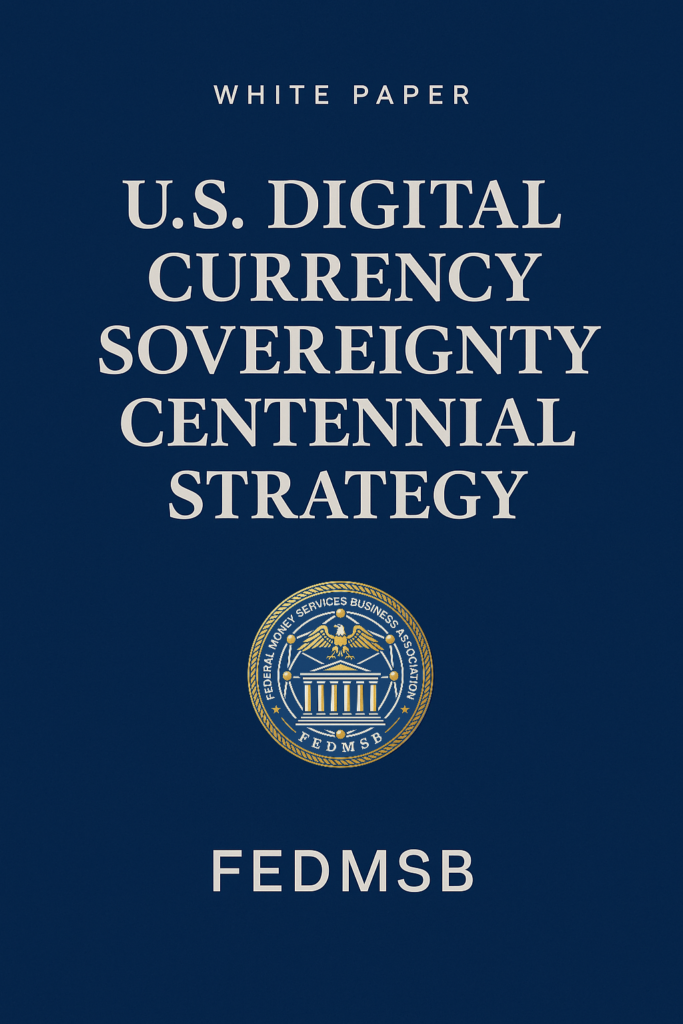Introducing the Groundbreaking CIFB Doctrine and Proposing a “Double Strike” on Crypto Giants Binance and Tether
Manhattan, NYC | June 9, 2025 — The Federal Money Services Business Association (FedMSB) today announced the forthcoming release of its landmark publication, the “U.S. National Digital Currency Sovereignty Centennial Strategy White Paper”, which lays out a generational vision and strategic doctrine for securing American leadership in the global digital financial system over the next century.
The White Paper addresses rising systemic threats from stateless and opaque financial networks, most notably those shaped by Tether (USDT) and Binance—entities functioning as quasi-sovereign monetary systems. Central to the strategy is the introduction of CIFB (Clearing Illegal Financial Black Markets), a bold, preemptive doctrine that moves beyond conventional Anti-Money Laundering (AML) and Counter-Terrorism Financing (CTF) models. CIFB targets the structural dismantling of illicit digital liquidity ecosystems that erode sovereign control, circumvent legal jurisdiction, and destabilize global monetary governance.
In tandem, the report advances the Double Strike + Double Support policy framework: a dual-action strategy aimed at dismantling shadow utilities while scaling transparent, compliant U.S.-regulated infrastructures such as USDC and Coinbase. This is not a containment strategy—it is a construction blueprint for embedding democratic values, lawful oversight, and institutional accountability into the future of digital finance.
This White Paper reaffirms the United States’ resolve not just to participate in the digital financial era, but to lead it—by writing the rules, operating the rails, and anchoring the system in democratic sovereignty.
For the full document and future updates, please visit: U.S. National Digital Currency Sovereignty Centennial Strategy

Executive Summary
Overview of the Strategic Vision
The 21st century has unveiled a new frontier of geopolitical rivalry: the domain of digital finance. As decentralized cryptocurrencies and privately-issued stablecoins proliferate across borders, they no longer remain fringe innovations—they are evolving into alternative monetary regimes, challenging the traditional levers of economic governance: monetary control, capital sovereignty, and lawful transparency.
This White Paper presents a generational imperative and a civilization-scale doctrine: to ensure the United States does not merely survive this monetary evolution, but architect its design, command its rails, and defend its values—over the next century.
America must not be a follower of digital transformation; it must become the sovereign operating system of the world’s lawful financial infrastructure. What railroads were to the industrial age, digital ledgers are to the sovereign age. The challenge is not whether America adapts—it is whether America governs.
The Double Strike + Double Support Doctrine
At the heart of this strategy lies a dual-action policy—Double Strike + Double Support—designed to both neutralize threats and construct a sovereign path forward.
Double Strike
Targets Tether (USDT) and Binance, two private, opaque entities that now function as unregulated, quasi-sovereign financial systems. These entities act as shadow central banks—absorbing global fiat, enabling uncontrolled cross-border flows, and constructing an anarchic, stateless liquidity regime. Their scale, transactional opacity, and extrajurisdictional operations create systemic risk to both national monetary authority and global regulatory coherence.
They represent not decentralization, but the emergence of a darkly centralized, post-sovereign financial power—unaccountable, unchecked, and capable of engineering economic outcomes with no democratic mandate.
Double Support
Simultaneously, the United States must uplift and integrate two compliant, auditable infrastructures aligned with democratic rule and monetary oversight: USDC and Coinbase. These represent not just “alternatives” but the core foundations of a rule-based, sovereign-led digital economy. Their transparent architecture can be scaled within the bounds of U.S. law and serve as compliant international financial highways under American influence.
This policy is not a containment strategy—it is a construction strategy. It absorbs global liquidity into lawful channels, secures settlement sovereignty, and embeds democratic values into the digital monetary layer.
CIFB – Clearing Illegal Financial Black Markets
To legitimate and globalize this doctrine, we introduce CIFB—Clearing Illegal Financial Black Markets—as the strategic banner for international alignment and domestic enforcement.
CIFB is to digital finance what counterterrorism was to post-9/11 geopolitics: a moral, strategic, and operational doctrine. It is not reactive—it is preemptive. It does not merely regulate transactions—it dismantles dark architectures. It frames the true nature of the threat:
! This is not harmless innovation.
- It is the intentional construction of a stateless monetary regime—cloaked in the language of decentralization, but operating as a centralized, opaque, and non-accountable financial insurgency.
- It evades democratic oversight, circumvents sovereign jurisdiction, and corrodes the lawful foundations of global finance—including sanctions enforcement, monetary policy, and judicial reach.
CIFB asserts: No ledger is above the law. No operator is immune to scrutiny. No network escapes sovereign responsibility.
This is not about suppressing innovation—it is about removing the underworld reefs on which lawful innovation may run aground.
CIFB is not regulation. It is defense of order.
Historical Imperative: From Defense to Design
The stakes are not merely economic—they are civilizational. If the United States fails to assert digital sovereignty, it will become a tenant in financial systems architected by rogue actors, adversarial states, or stateless code.
History belongs to the architects of systems, not the victims of disruption. Like the Bretton Woods moment, or the birth of the internet, we are once again at a junction where who controls the rules determines who controls the future.
The goal is not to crush new systems—but to own the rails, write the protocols, and anchor the values of digital finance in the democratic, auditable, and lawful vision of the United States.
Conclusion
- Double Strike. Double Support. CIFB.
- This is not a reactive posture—it is a sovereign declaration.
- The era of stateless liquidity is ending.
- The age of American-coded finance is beginning.
This White Paper is not simply a policy guide. It is a doctrinal foundation for U.S. digital supremacy—one that will define legitimacy, power, and prosperity over the next century.
